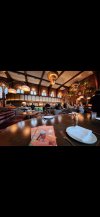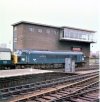I have a couple questions on what St Pancras was like before HS1 was built:
...
Did it feel massively empty, such a large building for just the MML
It all depends on what you mean by "before HS1 was built"?
As others have detailed what you term "
just the MML" (my bold) carries with it a whole range of meanings. (Indeed, the line was not called the MML until 'privatisation' in the 90s.)
As
@62484GlenLyon explains very well, in the c 69 - 75 era, there were four passenger workings each hour in and out - 1 Luton DMU, 1 Bedford DMU, 1 Sheffield via Derby or Notts and 1 semi-fast Notts or Derby/Manchester Picc.
But from Sept 62 to April, 1966 there were possibly more trains per hour, because St Pancras was the main station for London - Manchester traffic while the WCML was being electrified south of Crewe. (at the end of that period, it was basically an hourly service)
Prior to, I think it was 1962, certainly in 1961 there was a far more eclectic mix of 'intercity' destinations, with more through trains to Leeds and through carriages to places like Halifax, plus Edinburgh in the form of The Waverley and overnight sleeper. Up to about 1960, and at holiday times there were also reliefs to Glasgow. (Until then, London to Scotland using the Midland was slower than either the ECML or the WCML, but still seen as a useable route.)
Furthermore, in steam days (ie up to Sept 62) there were more ECS workngs to Cricklewood (for servicing) and light engine movements to get locos back to Kentish Town for turning. As a kid, I wasn't able to spend any time there, but I suspect what Glen Lyon refers to as the A, B and 8 roads (below) were engine release roads - that is, the train engine of an arriving passenger would stop short of the buffers, uncouple, draw forward, and then reverse out of the station via one of these 'sidings'. This enabled the loco to be turned, coaled and watered much more quickly, rather than stand awaiting its coaching stock to leave, and then following it out.
(As I say, I never spent any time at the station in those days. Maybe a better informed reader can confirm/deny these as 'release roads'.)
Until the electrification and resignalling works of the early 1980s there were 7 platforms. No.1 platform was shorter than the others and was rarely used for anything other than a DMU on the suburban services to Luton. This platform was on the extreme left side of the station looking out from the buffer stops. It didn't survive the modernisation. There were also two sidings between Platforms 2 and 3, known as A road and B road and another siding between platforms 4 and 5 known as 8 road. Only one of the two sidings between Platforms 2 and 3 survived.
Either way, the point is that, yes, after the local services were diverted as Thameslink in the 1980s, it indeed left the area under the grand arch somewhat devoid of many train movements each hour, but if you go back in time the station was much busier than you'd have found it in, say, 1990.




